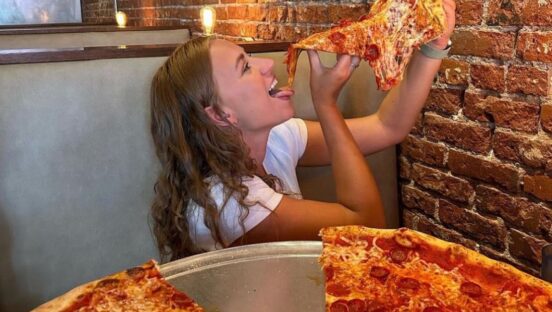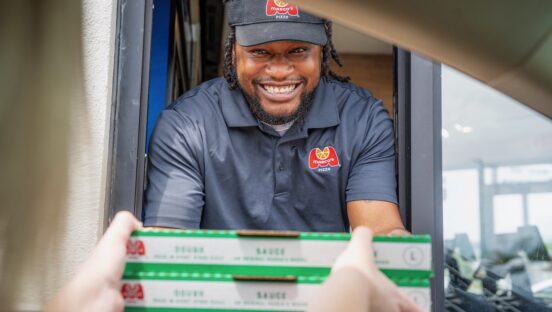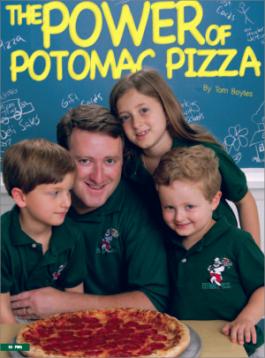 Finding a formula for success in the pizza business is never the same from one store to the next, but there are certain elements that are present in nearly every successful restaurant.
Finding a formula for success in the pizza business is never the same from one store to the next, but there are certain elements that are present in nearly every successful restaurant.
First, you have to truly love what you do. An old friend once told me, “If you enjoy what you do for a living, you’ll never work a day in your life.” Adam Greenberg, owner of Potomac Pizza in Potomac, Maryland, has been fortunate enough to find just that kind of position in life. It’s not so much that he loves making pizza, which he does, but the fact that he has found a career where he gets to help his community, be involved with his kids and their school life, constantly challenge himself and build a successful business. In this article, you will see how his becoming involved in the local schools, giving back to the community and proactive thinking has made his Potomac Pizza restaurants such a success.
Background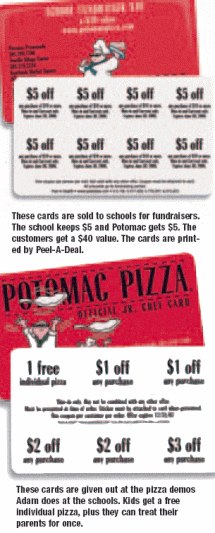
While attending college, Adam got his start delivering pizza for Domino’s. In 1992, he decided to strike out on his own and open an ice cream shop called The Cone Zone. Two years later he opened another location in Bethesda. It wasn’t long before he made the connection between ice cream and pizza and purchased the original Potomac Pizza in June 1995. A couple of years later he sold his two Cone Zone locations and opened Potomac Pizza/Cone Zone in 1999. In 2002, he bought Potomac Village Deli and in 2003 he opened the third Potomac Pizza in Traville Village. He now has three pizzerias, one ice cream parlor and one deli and also has a great catering operation that utilizes all four locations. So what is his secret? It’s not really a secret according to him…it’s a grassroots campaign with all sights aimed at giving back to the community, educating and entertaining kids and forward thinking.
Working with Schools
Let’s jump right into some of his marketing and how it started. Adam purchased Potomac Pizza and has tripled sales since he bought it. He attributes much of this to community involvement and working with the schools, but adds that without a dedicated staff, great partners and a little luck, he would have never been able to do this. “Six years ago, I thought it would be a good idea to go to the school and show my daughter’s class how pizza was made,” Adam says. “I saw how happy and entertained the kids were and thought to myself ‘Wow! What an idea.’ I created a program where I go to the schools and do demonstrations teaching kids about cheese, tomatoes, pizza and the importance of cleanliness. Now, 99 percent of the kids in my area know who I am and so do their parents.”
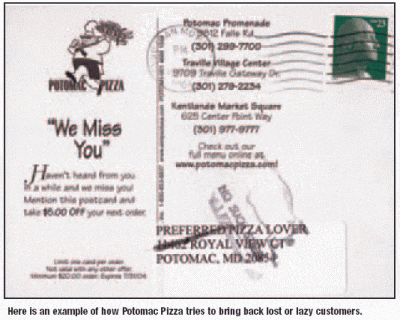 Adam visits the schools and sets up his demonstration. He calls it grassroots marketing. He usually targets second and third grades and loads his catering trucks with enough dough balls, cheese and sauce for all of the kids in the grade, usually between 100 to 120. For this he usually brings about 150 to 160 dough balls. The demonstration is set up in the school’s cafeteria. First, he tells them things about a pizzeria, like why the boxes come unfolded. He gives them a box, shows them how to fold it and let’s them fold their own. Students are then given a dough ball and he shows them how to stretch it out. Before this begins he has everyone wash his or her hands and explains the importance of cleanliness. Then he tells them how tomatoes are grown and goes around and places a dollop of sauce in the middle of their dough. Next, he tells them about cheese and where it comes from and has them scatter the cheese on their pizzas. Once the demonstration is over they box up their pizza and are given instructions on how to bake it when they get home. He sets all of this up near the time school is to let out so they can take it directly home and put it in the refrigerator or have their parents help bake it right then. Before they head home he brings out pre-made pizzas and everyone gets to eat. He asks for one volunteer from the school for every 10 students.
Adam visits the schools and sets up his demonstration. He calls it grassroots marketing. He usually targets second and third grades and loads his catering trucks with enough dough balls, cheese and sauce for all of the kids in the grade, usually between 100 to 120. For this he usually brings about 150 to 160 dough balls. The demonstration is set up in the school’s cafeteria. First, he tells them things about a pizzeria, like why the boxes come unfolded. He gives them a box, shows them how to fold it and let’s them fold their own. Students are then given a dough ball and he shows them how to stretch it out. Before this begins he has everyone wash his or her hands and explains the importance of cleanliness. Then he tells them how tomatoes are grown and goes around and places a dollop of sauce in the middle of their dough. Next, he tells them about cheese and where it comes from and has them scatter the cheese on their pizzas. Once the demonstration is over they box up their pizza and are given instructions on how to bake it when they get home. He sets all of this up near the time school is to let out so they can take it directly home and put it in the refrigerator or have their parents help bake it right then. Before they head home he brings out pre-made pizzas and everyone gets to eat. He asks for one volunteer from the school for every 10 students.
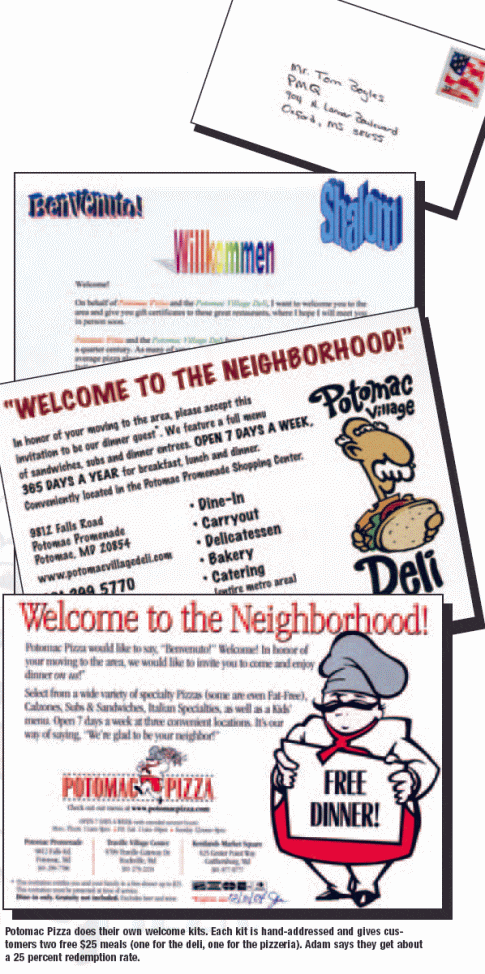
“Doing something like this takes a lot of time,” Adam says. “Kids are very impressionable, and I personally do all of the demonstrations. From start to finish, it takes between three to four hours per demonstration to pack up, set up the demo and get back to the shop. I have estimated it costs me between $3 and $5 per kid, but I look at it as a marketing cost. Before each child goes home, I give them a card making them a Junior Chef, which is good for a few dollars off their next visit. The value is the loyalty of these kids. Kids determine where the parents eat, so the money I spend is for marketing.
“I had one customer drive 45 minutes to get a pizza. He told me that the family was going out for pizza and his daughter looked up at him and told him the only pizza she eats is Potomac Pizza. He said she didn’t give up until he said they would go there for pizza, so he drove 45 minutes across town because his daughter wanted Potomac. Long-term, this is one of the best marketing strategies we have.”
Working With the Community
Just about any group who wants help from Potomac Pizza gets it. Adam says that they do not have a set budget for legit projects. “Anyone who can show us that they are legit and trying to raise money for some community project gets our help. We can’t say ‘Hey, we’re out of budget.’ We just do it. They get an info packet sent to them that day,” Adam says. For most fundraising groups, he lets them know what he has to offer and finds out what kind of event they are having. Once this is determined, they set up their catering trucks and trailers and sell food. They give up to 25 percent off the top to the groups to help out with whatever project for which they are raising money.
New Neighbors and Marketing
Another successful strategy Adam employs is their Welcome Kit. “My wife hand-addresses all of the Welcome Kits we send,” Adam says. “We get a list of new people who move in to our area and send them a coupon good for one free dinner ($25). We also include information about who we are, where our locations are, what hours we are open and what we have to offer. It is only good for dine-in. I believe that carryout and delivery customers all come from a dine-in experience, so we have them come in to experience all we have. We offer so much more than pizza and they don’t get that experience unless they come in to eat. I like this strategy because new movers haven’t had time to pick a favorite place yet, and this gets us in the door first. We send anywhere from 300 to 600 of these kits each month and get about a 25 percent redemption rate. My wife just loves it,” he says sarcastically. “I’d rather give away a free meal and get new customers in than offer a $5 or $10 discount. I think it works better.”
VIP Cards
“One of the marketing strategies we tried was a VIP card,” Adam says. “When I opened my first location, a marketing company came to me and wanted to produce a card valued at $120. The sold them for $43, and the company kept proceeds for printing and sales. We didn’t think it would sell for that amount, but it wasn’t going to cost us anything so we tried it. They sold 550! The only problem was that they didn’t have an expiration date. We still get some of them today.
“When I opened my second location I decided to print the cards myself and have them numbered and let the local PTA sell them. We printed 1,000 cards with the face value at $40. The PTA kept $10 and we got the rest for printing and food costs. The cards had a $140 value to the customer. There was one discount for $20 off dine-in, $15 off carryout and $10 off delivery. There were several discounts for $10 off a $20 purchase and $7 off a $14 purchase. The PTA only sold 50 cards. The problem was that it was a hard sell. You have to get the $40 right there on the spot.
“We went to another company and asked if they wanted to sell our cards, which had a $40 face value and they could keep the money. They did some testing and said at $40 they didn’t sell any, but at $20 and $25 they sold fantastic. They sold 900 of the cards we had left. Later, we had another company do the printing and selling cards. The cards gave customers two $15 off offers with no purchase necessary and they sold 2,000. The problem was most were sold to existing customers. In areas where you already have customers, it cannibalizes sales. These offers and ideas are great, but only in new areas and for new start-up operations. If I do it again, I will offer two free one-topping pizzas instead of $15 worth of food.”
Fixing Mistakes
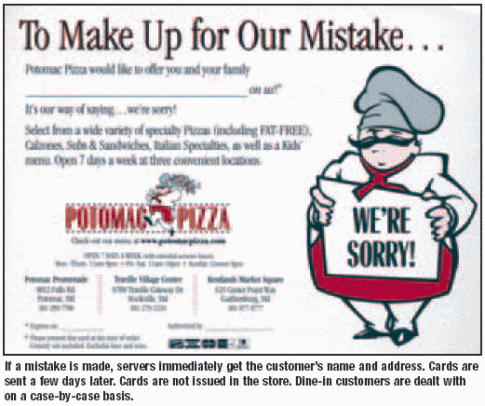
Everyone who owns a pizzeria makes mistakes on orders. We are all human and so are the people working with us. The secret is turning these mistakes into marketing and not lost customers. For this, Potomac Pizza uses on-the-spot redemption tactics and postcards to ensure customers aren’t lost to the competition. “When a mistake is made on a delivery or take-out order, we send a postcard a couple of days later with an appropriate offer,” Adam says. “Each one is dealt with on a case-by-case basis. Our postcards have an apology and a blank space where we can write in the offer. Sometimes it is just a few dollars off the next visit or a free item; sometimes it is a free meal. I like to send them out a few days later after they have had a little time to cool down in case they are really ticked off. Most people just want acknowledgement of the mistake and this reinforces that you know about it and want to make it right…not just take their money.”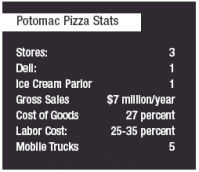
Adam has a different approach for dine-in mistakes. “As I said, each problem is handled on a case-by-case basis, but I never give out a mistake card in the restaurant. I try to fix it right there with a replacement or free meal. In many cases, we get their name and address immediately and send a card later. I would rather give away a meal than lose a customer for life. The reason I don’t give out cards in the restaurant is because I don’t want them walking out with a card, I want them walking back in with a card.”
Catering Trucks
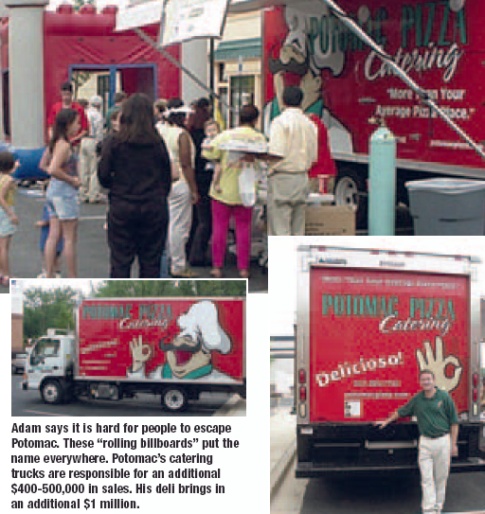
In addition to doing around $7 million a year in the pizza restaurants and deli, Adam says they earn $400,000 to $500,000 a year through the use of their catering trucks. “Our biggest truck is a 16-foot cab-over that cost about $70,000. We have several trucks and trailers we use for events that are really powerful marketing tools. Not only are these trucks great rolling billboards, they are tools we use. Every time I do a school demonstration, catering event or festival, these trucks are displaying our logo and information. We do a lot of end-of-the-year school functions, local festivals, events and some corporate catering,” Adam says.
“When we do school-related events, we give up to 25 percent off the top back to the schools. It’s another way I try to give back to those who have helped me. We are in everyone’s face everywhere they go in a very good way. We do pool parties, picnics sporting events…just about anything. We have two trailers we can cook in, but at most events the trucks are used as storage vehicles to keep the pre-made pizzas and other items either hot or cold. For these events, especially corporate events, we’ll do anything they want, such as wing buffets or one like next week where we are doing a fajita buffet. We do a lot of catering. Through the deli side, we do over $1 million a year.
“The biggest mistakes you can make are picking the wrong events or preparing too much food. Once you are at an event, like a festival, you only have a couple of days to do your thing. At one event we paid $8,000 just to be able to set up. After the first three hours, I was stunned at how little we were selling. It was something like $300 an hour. So we jumped the counters and got in people’s faces. You have to sell and push your products. Get in their faces. When going out on catering events, don’t forget about why you are there. Is it just to make money or is it to promote your restaurant? Remain focused and give it 100 percent. Eighty percent of our catering and event strategies are designed to promote the restaurant.”
Advice
“The best advice I can offer is to work with the community. And, don’t forget about your most important asset, your staff. Without a strong staff you can achieve nothing. Treat them with respect and the way you would want to be treated yourself. This is just a job and if you don’t take care of them they will find another job, possibly even if they make less, where they will be happy. I am only one person with a staff of 120 amazing individuals. They are the true reason Potomac Pizza is a thriving success. I just happen to be the front man standing in the limelight. Behind every successful business there are many people who have actually made the business great. I have the world’s best staff and this is what has helped Potomac Pizza become successful,” Adam says. “Don’t worry about every little penny you spend on marketing because sometimes marketing dollars are spent in different ways, like with the school demonstrations. Just look at the big picture and treat everyone with respect. Always be proactive and never react to what the guy across the street is doing. If you worry about what he is doing, you’ll be in for a hard time, and it can kill you. You also have to be able to sell yourself. Make yourself and your business shine.”
Anniversary and Grand Opening


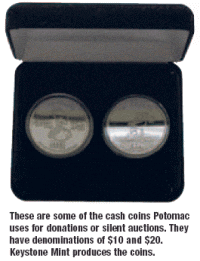 To help promote Potomac Pizza's 25 aniversary and grand opening of the third Potomac Pizza, Adam employed several marketing strategies. Among these were a live radio remote, inflatable kids jumping arena and the Roadshow Visual Noise crew. "The props they (Roadshow crew) brought out, along with our radio station and Hummer giveaway was a home run," Adam said. "The sales in our store that Saturday were up almost 30 percent and it helped us log in our best Saturday at the new store, which had been opened for four months. The event helped put us on the map and on the road to a great future. The store has had a steady increase of 20 percent a month (over last year) since the event. I would highly urge people to try this out for their grand openings, but remember a successful event is only as good as the time and effort you put into it." The Pizza Roadshow was a fantastic success.
To help promote Potomac Pizza's 25 aniversary and grand opening of the third Potomac Pizza, Adam employed several marketing strategies. Among these were a live radio remote, inflatable kids jumping arena and the Roadshow Visual Noise crew. "The props they (Roadshow crew) brought out, along with our radio station and Hummer giveaway was a home run," Adam said. "The sales in our store that Saturday were up almost 30 percent and it helped us log in our best Saturday at the new store, which had been opened for four months. The event helped put us on the map and on the road to a great future. The store has had a steady increase of 20 percent a month (over last year) since the event. I would highly urge people to try this out for their grand openings, but remember a successful event is only as good as the time and effort you put into it." The Pizza Roadshow was a fantastic success.














